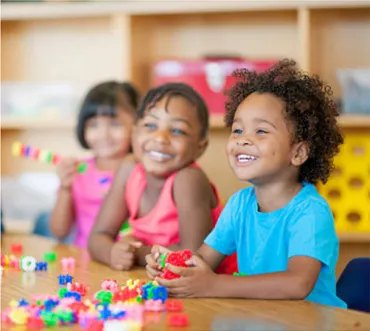Three Strategies to Welcome Infants, Toddlers, and Two-Year-Olds to Your Program


This is the time of year that many people think about as the “back-to-school” season, but we know that the “back-to-school” season looks different for our youngest learners.
The Creative Curriculum currently offers guidance for the first six weeks of school for teachers of preschool and kindergarten classrooms, but how is that guidance different for teachers of infants, toddlers, and two-year-olds? “The first six weeks” for a child entering an infants, toddlers, or twos program may come at any time during the calendar year. Whether they are small, family childcare providers or larger organizations with multiple classrooms, these programs welcome children all year long, not just in August or September.
Children will spend many hours in the program, so creating a welcoming place for children and families where their health and safety are prioritized is essential. Below, I have outlined three key points for program leaders and educators to think about when welcoming new children and families to their program, no matter what time of the year it is.
1. Prioritize Meaningful Partnerships With Families
Building positive relationships with each child and family remains crucial, no matter when a child enters your program. An easy first step is inviting the child’s primary teacher to be part of the initial meeting with families, when they first come to enroll their children.
Often, it’s the program administrator or director only who meets with the family, but there are so many benefits to having the teacher meet with the family, too: not only for the teacher and the family, but, ultimately, for the child. I tell program directors to introduce themselves to the family and then go cover for the teacher so they can meet with the family. This allows the family to actually engage with the person who’s going to be taking care of their child. Knowing what that person looks like and how they interact with people is essential for starting that positive relationship.
Families are looking for a person they can trust. They need to know what this person is like, this person they are trusting with the most precious thing in their lives. They want to trust that this person will not only take care of their child’s physical needs but be kind to their child and nurture their social–emotional development. They are looking for someone who will love their child just as much as they do. Our LearningGames help teachers connect with families, such as by smoothing the process of saying good-bye when children are left in their care.
2. Focus Your Initial Caregiving on Children’s Routines
In the first meeting with a family, start a conversation about the child’s routines. Eating and mealtimes, sleeping and resting, diapering and toileting, and getting dressed take up a great deal of a young child’s day. So do transitions. “Hellos and Goodbyes” are particularly significant transitions for a child, such as when a family member drops off a child in the morning and picks him up again at the end of the day. Knowing how a child handles the many transitions they encounter each day will help the teacher know how to support them. The important thing is that, rather than adapting the child to meet the needs of the program, the program and teacher need to know how to meet the child’s needs and support the routines the child is already used to.
Within The Creative Curriculum for Infants, Toddler and Twos, there are forms to gather information about each child’s routines. This information helps caregivers understand how to plan for arrivals and what children’s eating, dressing, sleeping, diapering, and toileting routines are before they enter the program.
3. Respond to the Unique Needs of Infants, Toddlers, and Twos
We always want to be able to respond to children’s needs and interests in the moment. Having strong routines makes responsiveness so much easier. Knowing when a child needs to rest, when they need to eat, and when they need to have their diaper changed prevents so many meltdowns! When routines are strong, the child enjoys a sense of security and builds a positive attachment to their caregiver, which lays the foundation for their many personal relationships to come.
In addition, it’s important to understand the child’s basic temperament. Families have always known, and now there’s scientific research to support the idea, that children display unique temperaments almost from birth. Ask family members about things such as how their child reacts to changes in their environment, how they react when meeting new people, and how they approach new tasks and challenges. When are they happiest? What are they scared of? Some children seem to just “go with the flow,” while others require a great deal of adult guidance and patience.
Teaching Strategies provides several great resources to help guide this initial conversation with families as well as to facilitate ongoing plans to support children’s development and learning. In the back of Volume 1 of The Creative Curriculum for Infants, Toddlers & Twos is an appendix that includes some very helpful forms that teachers can photocopy. They include quite a few questions that teachers can ask families to get to know children well. Gathering this information will help teachers build that lasting, positive, trusting relationship that is essential to children’s development.

Support the development of the whole child
Explore high-quality, comprehensive resources that help you intentionally teach and care for our youngest learners during these most critical and formative years of development.